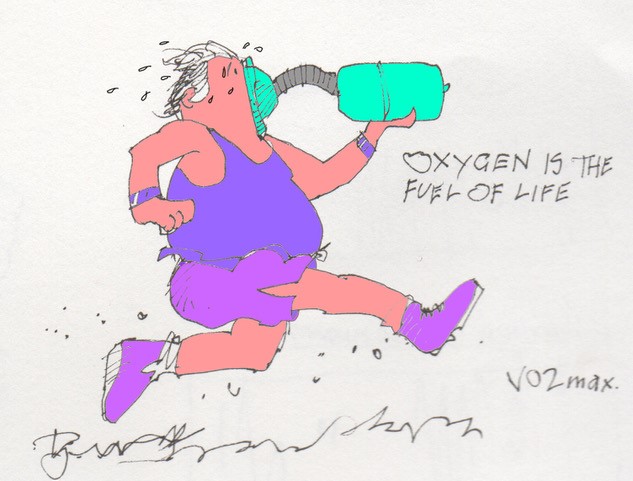LUNG DISEASE
Lung disease encompasses a large collection of widely varying chest conditions. The commonest include chronic obstructive pulmonary disease (COPD – what used to be referred to as chronic bronchitis and/or emphysema), asthma and pulmonary fibrosis. They share the feature of causing more than usual breathlessness at levels of exertion that would normally be tolerated well.
COPD
COPD is caused by a combination of progressive narrowing of the airways and loss of a proportion of the air sacs that make up the bulk of lung tissue. The main causes are cigarette smoking, asthma over many years and exposure to air pollution. There are more than a million people with COPD in the UK and each year there are about 30,000 deaths.
Asthma
About 12 per cent of the population has been diagnosed with asthma. It is more common in children and young adults, but may continue into old age by when it has often morphed into COPD. There about 1,200 deaths from asthma annually in the UK.
Pulmonary fibrosis
Pulmonary fibrosis is caused by progressive increases in fibrous (scarring) tissue in the lungs, interfering with the ability of the lungs to absorb the oxygen upon which we depend. It is a condition of later life, there are several different forms and the cause is often unknown. There are about 35,000 sufferers in the UK with an annual death toll of about 5,000.
Exercise and lung disease
There is no lung disease that is caused by or aggravated by lack of exercise (except when this has resulted in obesity), but any loss of lung function has effects which can be helped by being active and physically fit. When lung function is impaired, the supply of oxygen from the lungs to the blood is compromised. Lung function is not normally a limiting factor in exercise tolerance. The oxygen saturation of arterial blood is still high at maximal exercise. This is not true of exercise for patients with lung disease. As they increase the intensity or duration of exercise, the oxygen saturation of their blood falls progressively until breathlessness prevents further effort.
Exercise in the management of lung disease – pulmonary rehabilitation (PR)
Patients with chronic lung disease inevitably have low levels of physical fitness, a consequence of their limited exercise tolerance and their inability over a long period of time to take much exercise. Pulmonary rehabilitation (PR) has developed over the past 20 or so years and aims to reverse this loss of fitness by providing a programme of graduated exercise within the limits of the patients’ breathlessness. It works by increasing ‘peripheral’ fitness – more efficient blood flow to the working muscles and more efficient muscular performance. These changes allow better physical functioning despite the limited rate of oxygen provision.
COPD
PR has been shown to improve symptoms, give greater exercise tolerance and lengthen life for COPD patients. A Cochrane systematic review of PR included 64 randomised controlled trials with 3,822 participants. The conclusions were that ‘pulmonary rehabilitation relieves breathlessness and fatigue, improves emotional function and enhances the sense of control that individuals have over their condition. These improvements are moderately large and clinically significant. Rehabilitation serves as an important component of the management of COPD and is beneficial in improving health‐related quality of life and exercise capacity.’ The report found that hospital-based programmes were more effective than community programmes, but that the complexity of the intervention made no difference – it was just the exercise that did the business. PR works better if it is started as soon as possible after the episode of lung problem that initiated it. Among 2,700 COPD patients who started their PR programme within 30 days of an episode, the mortality at one year was 7.3 per cent compared with 19.6 per cent who started later or not at all.
Other lung conditions
All patients with lung disease can benefit from exercise training but pulmonary rehabilitation programmes are underfunded, under-resourced and under-provided both in the UK and the USA. NICE recommends PR for patients with COPD but not routinely for asthma or other lung diseases though they should all benefit from this approach. Fortunately, pulmonary patients can gain the considerable benefits of exercise from any source.
A questionnaire study of asthmatic patients found a correlation between control of symptoms and exercise frequency and intensity, improving from low to medium to high exercise loads but decreasing slightly for very high exercise loads. Both aerobic and muscle strengthening are effective.
Protection from infection
Regular exercise does not reduce the risk of catching respiratory infections, but it does reduce the severity and duration of the resulting symptoms. People with lung disease are rightly regarded as very vulnerable to the ill effects of Covid and accounted for many deaths during the pandemic. People with lung disease who exercise regularly have a lower risk of premature death than non-exercisers.
The future
Reducing rates of smoking, lower levels of pollution and better treatment of asthma should all help to reduce the prevalence of disabling lung disease. Nevertheless this trend will be partly reversed by the increasing age of the population – the longer you live with the causes of lung diseases the more likely it is to catch up with you. So I would press for much better PR provision and for long-term programmes – which do not at the moment exist.
Subscribe to the blog
Categories
- Accelerometer
- Alzheimer's disease
- Blood pressure
- BMI
- Cancer
- Complications
- Coronary disease
- Cycling
- Dementia
- Diabetes
- Events
- Evidence
- Exercise promotion
- Frailty
- Healthspan
- Hearty News
- Hypertension
- Ill effects
- Infections
- Lifespan
- Lipids
- Lung disease
- Mental health
- Mental health
- Muscles
- Obesity
- Osteoporosis
- Oxygen uptake
- Parkinson's Disease
- Physical activity
- Physical fitness
- Running
- Sedentary behaviour
- Strength training
- Stroke
- Uncategorized
- Walking


